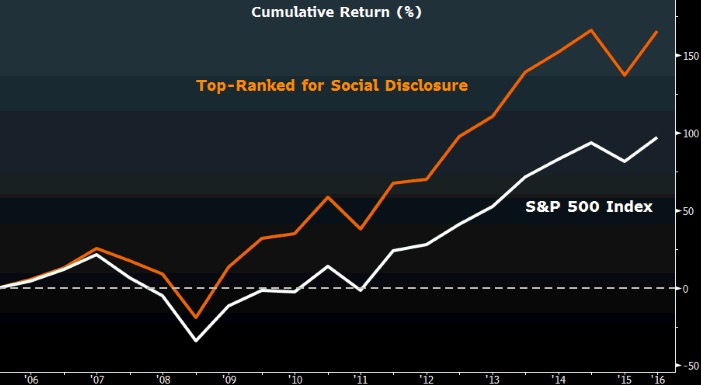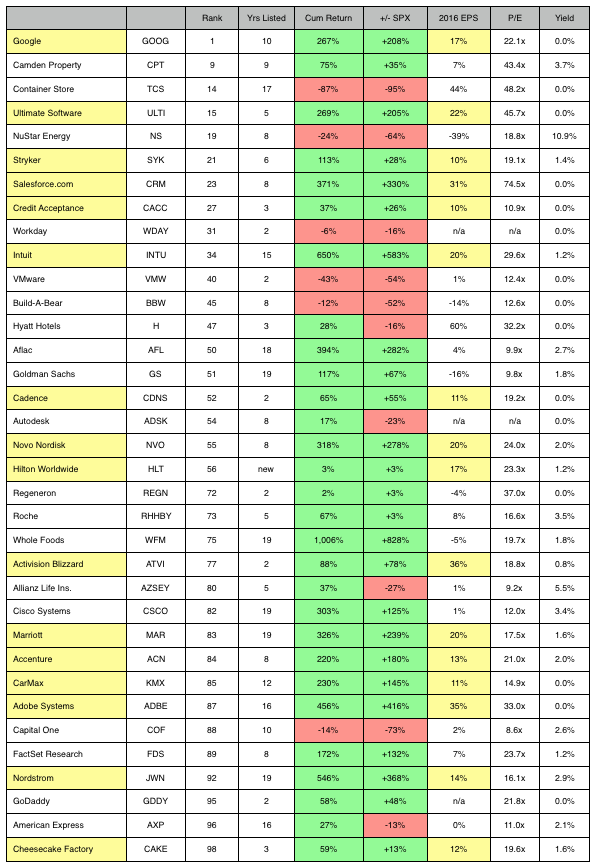Culture Club
15 “Best Places to Work” … and Own
- Companies prioritizing people significantly outperform the S&P 500 Index
- Cutting employee turnover in half improves operating budgets up to 6%
- Seven Secrets to inspire, motivate and retain talent
- The man who humanizes money management https://www.youtube.com/embed/dumAFMBisSo
Fortune Magazine publishes its annual ranking of 100 “Best Places to Work” and wealth management firm Edward Jones makes the list for 17 years running. We expect places like Google to attract accolades –with free gourmet lunches, onsite laundry service and lego play rooms– but a place where you buy life insurance and fund a 401(k)? Admittedly we were surprised, especially since the firm had made the cut so many times. Then Fortune invited us to meet the person at the helm of this decades old partnership, Managing Partner Jim Weddle (link to interview https://www.youtube.com/embed/dumAFMBisSo). We soon realized Jim is not only doing something right, but knows exactly what he’s doing.
Jim joined the company back in the 1970s, fresh out of business school. He admits his work ethic was “pretty good but still needed encouragement from time to time.” So a senior partner quietly took Jim under his wing, and within a couple years asked him to open a new office in rural Indiana. Jim prided himself on knowing the name of every client who walked in the door and always having a fresh pot of coffee in the pantry… generally starting at 6am. Several years later Jim was asked to oversee the entire retail network. Today Edward Jones has over 11,000 locations.
Jim’s small town charm has produced big time results, in part because he’s figured out how to quantify a culture and implement at scale. Fortune tracks these metrics to determine its annual ranking of Best Place to Work. So does Bloomberg, in its own version called a Social Disclosure Score. SDS measures factors like employee turnover, gender equality, and corporate governance. As we can see from the data, SDS has as much impact on shareholders as employees.
Nice Guys Finish First
SDS Portfolio Outperforms

Based on rebalancing the portfolio every six months and back testing over a ten year period ended March 31, top-ranked SDS companies significantly outperformed the broader market, returning 165% compared to 97% for the S&P 500. Whether looking at Fortune’s ranking or Bloomberg’s data, the point here is obvious: Positive culture is positive for shareholders.
While Bloomberg’s SDS ranking is based solely on numerical measures, Fortune’s methodology merges qualitative information with quantitative data. We counted 51 separate categories on which companies are judged, not to mention hundreds of written responses from surveyed employees. For those of us who generally opt for data over anecdote, and yet still appreciate the softer side of due diligence, this approach is very satisfying. Fortune’s process is exceptionally rigorous. In broad terms, Fortune’s criteria integrates two parallel data sets:
- Trust Index Employee Survey (67%) asks a random sample of employees to rate multiple factors like management credibility, job satisfaction, and co-worker camaraderie.
- Culture Audit (33%) measures specific metrics like compensation, benefits, turnover, hiring practices, methods of internal communication, training, recognition programs, and diversity efforts.
Turnover says a lot about a company’s culture, and the Fortune team notes the 100 Best Place to Work 2016 have half the turnover rate of non-ranked companies. In the notoriously volatile hospitality industry for example, 46% of employees leave every year, compared to just 21% for related companies which made the Fortune list. Accounting for the resulting loss to productivity, a 2006 white paper co-written by PricewaterhouseCoopers and the Saratoga Institute estimates resignations cost companies 90-200% of the departing employee’s base salary, ultimately adding 12% annually to enterprise operating budgets. By implication, cutting turnover in half reduces overhead by 6%, which in turn boosts margins and net income. So Fortune digs deep to figure out what keeps people loyal. Here’s Fortune’s take on Connecting People & Purpose: 7 Ways High-Trust Organizations Retain Talent.

At Edward Jones, the formula includes a powerful combination of mentoring, regular video town halls, generous incentive rewards, a priority on long-term growth over short-term metrics and a compelling sense of mission. As Jim told me, “What we do matters… and private partnership creates collaboration that supports robust mentoring across our firm… it’s also a significant strategic advantage. We are able to make decisions with a longer-term horizon.”
Having worked at both large public companies and small private partnerships, we agree wholeheartedly. Non-public companies can afford to take a longer-term view towards people and productivity. There’s only once catch: We cannot invest in private companies. So we consider only those 35 companies on Fortune’s 100 Best Place to Work which are public, narrowing the list to 15 based on our own criteria.
I’ve highlighted in green those companies with positive cumulative returns since joining the index, as well as those which have outperformed the S&P 500 over the same period. Underperformance by either measure is noted in red. Additionally, we’ve highlighted in yellow those companies whose 2016 earnings estimates exceed 10% AND whose returns are positive by both measures.

We observe the following from the data:
- 29 of 35 public companies currently ranked by Fortune have returned positive results for shareholders while on the list of 100 Best Places to Work.
- 25 of the 29 have also outperformed the S&P 500 Index during the same period.
- On average, current public companies ranked have made the list for 9.2 years.
- The average cumulative return for these companies while on the list has been 175%.
- Average outperformance compared to the S&P 500 Index has been 121%
While I would never buy a company simply because it has made Fortune’s list of 100 Best Places to Work, the data clearly illuminates the correlation between positive corporate culture and superior stock performance over time. An impressive 71% of public companies currently ranked by Fortune (25 of 35) have outperformed the S&P 500 Index while on the list, and the margin of outperformance has been significant.
I chose to highlight in yellow the 15 companies with 2016 earnings growth estimates exceeding 10% because growth is especially hard to find in the current environment. In fact, S&P 500 earnings for Q1 will likely constitute a third consecutive quarterly decline, the longest stretch since 2008. So we are being particularly narrow in our focus. We want culture AND we want results.
Culture and Growth
12-mo Returns through Q1

Of the fifteen “10% Growers” highlighted in yellow, we note 9 have posted positive returns for the 12 months ended March 31, 2016 while 6 have declined. The average return for the group of fifteen is 6.1%, compared to a decline of 2.1% for the S&P 500 Index.

